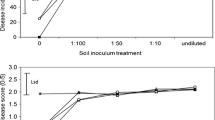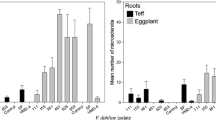Abstract
Population studies withVerticillium albo-atrum (microsclerotial form) have shown that a significant negative correlation exists between inoculum density in field soils determined before planting and yield of potatoes in some areas of Colorado but not in others. In Southern Weld and Morgan Counties where potatoes are planted early in sandy soils, reduced yield in Norgold Russet and Norchip cultivars occurred as inoculum densities increased. In Northern Weld County where potatoes are planted later in heavier soils, no such relationship was found. The significant relationship between inoculum density and reduced yield was associated with growing areas where conditions, particularly air temperature, appear to be favorable for verticillium wilt development when plants begin to mature.
A minimum number ofVerticillium propagules was required to cause significant yield reductions in total, marketable and U.S. No. 1 grade categories. Below this minimum number, no significant yield reductions occurred. In Southern Weld and Morgan Counties, this minimum number was found to lie between 17.5 and 23 propagules per gram of soil.
Controlled greenhouse studies showed that as air temperature decreased from 29.4 C (85 F) to 23.9 C (75 F) more inoculum was required to cause significant disease expression and to shorten plant life.
This study has shown that in some areas soil inoculum assays prior to planting may provide a basis for selecting fields which are safe for planting potatoes to avoid severe losses from verticillium wilt. Furthermore, they may help in identifying fields where preventive control measures may be required for satisfactory potato production.
Resumen
Estudios de poblaciones deVerticillium albo-atrum (forma microesclerótica) han demostrado que existe una correlación negativa entre densidad de inóculo en los suelos, determinado antes de la siembra, y rendimiento de papas en algunas áreas de Colorado pero no en otras. En los condados de Southern Weld y Morgan, donde papas son sembradas temprano en suelos arenosos, los rendimientos de los cultivares Norgold Russet y Norchip se redujeron a medida que la densidad de inóculo aumentó. En el condado de Northern Weld, donde se siembran papas en época mas tardía y en suelos más pesados, no se encontró ese tipo de relación. La relación significante entre densidad de inóculo y reducción de rendimiento estuvo asociada con áreas de siembra donde condiciones, particularmente de temperatura del aire, parecen ser favorables para el desarrollo de marchitez porVerticillium, cuando las plantas empiezan a madurar.
Un número mínimo de propágulos fue requerido para causar una reducción significante en rendimiento total, papa de mercado y categorïa de grado No. 1 según USA standards. Bajo este número mïnimo, no hubo reducción significante en rendimiento. En los condados de Southern Weld y Morgan, este número mínimo fue de 17.5-23 propágulos por gramo de suelo.
Estudios controlados en invernaderos demostraron que a medida que la temperatura del aire disminuyó de 29.4 a 23.9°C, mas inóculo se requirió para causar una expresión significante de la enfermedad y acortar la vida de la planta.
Este estudio ha mostrado que en algunas areas, el análisis de inóculo del suelo antes de sembrar puede proveer una base para seleccionar campos que son seguros para sembrar papas y asï evitar pérdidas por marchitez deVerticillium. Aún más, estos análisis pueden ayudar a identificar campos donde medidas de control preventivas pueden ser utilizadas para una satisfactoria producción de papas.
Similar content being viewed by others
Literature Cited
Ashworth, L.J., Jr., J.E. Waters, A.G. George and O.D. McCutcheon. 1972. Assessment of microsclerotia ofVerticillium albo-atrum in field. Soils Phytopathology 62:715–719.
Ashworth, L.J., Jr., O.D. McCutcheon and A.G. George. 1972.Verticillium albo-atrum: the quantitative relationship between inoculum density and infection of cotton. Phytopathology 62:901–903.
DeVay, J.E. and L.L. Forrester. 1972. Nature and concentration of propagules ofVerticillium dahliae in field soils relative to prevalence of Verticillium wilt in cotton plants. Phytopathology 62:754 (Abstr.).
Edgington, L.V. and J.C. Walker. 1957. Influence of soil and air temperature on Verticillium wilt of tomato. Phytopathology 47:594–598.
Frank, J.A., R.E. Webb and D.R. Wilson. 1975. The effects of inoculum levels on field evaluations of potato for Verticillium wilt resistance. Phytopathology 65:225–228.
Guthrie, J.W. 1960. Early dying (Verticillium wilt) of potato in Idaho. Univ. of Idaho Agric. Expt. Stat. Res. Bull. 45. 24 p.
Harrison, M.D. and C.H. Livingston. 1966. A method for isolating Verticillium from field soil. Plant Dis Rep 50:897–899.
Horsfall, J.G. and R.W. Barratt. 1945. An improved system for measuring plant diseases. Phytopathology 35:655 (Abstr.).
Pegg, G.F. and G.R. Dixon. 1963. The reaction of susceptible and resistant tomato cultivars to strains ofVerticillium albo-atrum. Ann Appl Biol 63:389–400.
Powelson, R.L. 1970. Significance of population level of Verticillium in soil. p. 31–33.In T.A. Toussoun, R.V. Bega and P.E. Nelson (eds.), Root diseases and soil-borne pathogens. Univ. of Calif. Press, Berkeley.
Spaulding, W.C. 1970. The effects of inoculum density on Verticillium wilt of potato. M.S. Thesis, Dept. of Botany and Plant Pathology, Colorado State Univ. 78 p.
Tolmsoff, W.J. and R.A. Young. 1957. Relation of inoculum potential ofVerticillium albo-atrum to development and severity of wilt in potatoes. Phytopathology 47:536 (Abstr.).
Tolmsoff, W.J. 1960. The influence of quantity of inoculum density on the severity of Verticillium wilt. M.S. Thesis, Oregon State Univ.
Wilhelm, S. 1955. Longevity of the Verticillium wilt fungus in the laboratory and field. Phytopathology 45:180–181.
Author information
Authors and Affiliations
Additional information
This work was supported by the Colorado State University Experiment Station and was a portion of a Master of Science Thesis submitted by the Senior Author. Published as Scientific Series Paper No. 2350.
Rights and permissions
About this article
Cite this article
Nnodu, E.C., Harrison, M.D. The relationship betweenVerticillium albo-atrum inoculum density and potato yield. American Potato Journal 56, 11–25 (1979). https://doi.org/10.1007/BF02851119
Received:
Issue Date:
DOI: https://doi.org/10.1007/BF02851119




